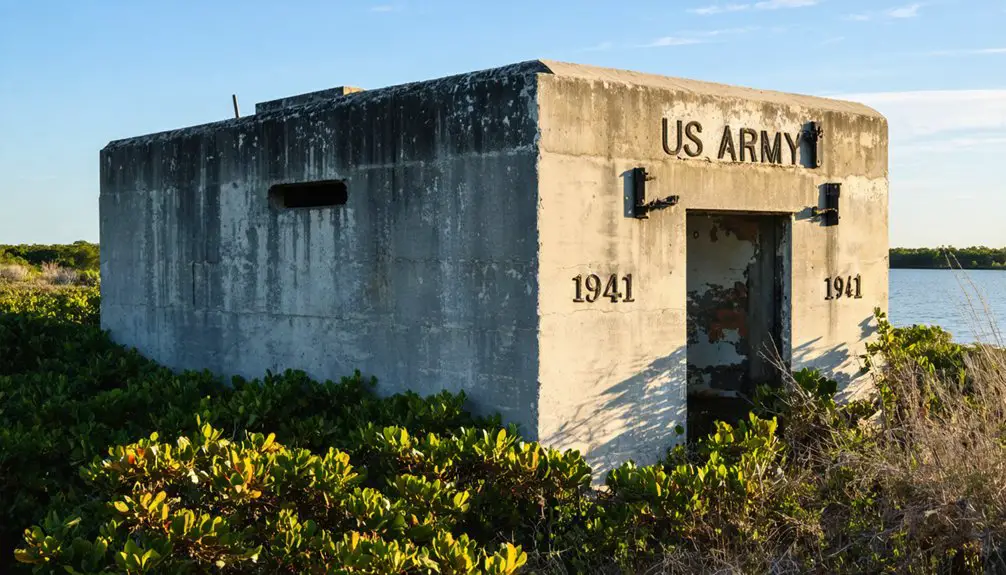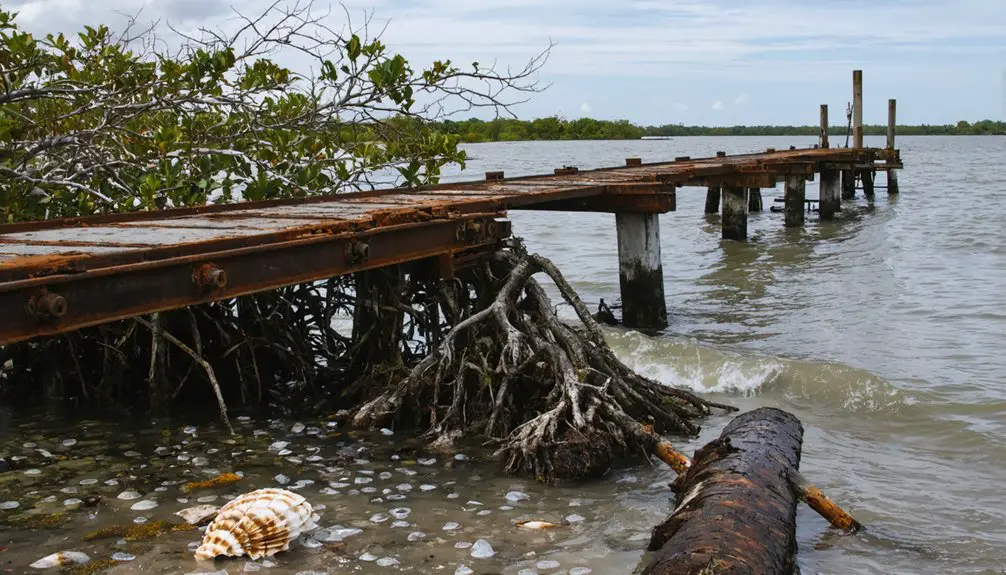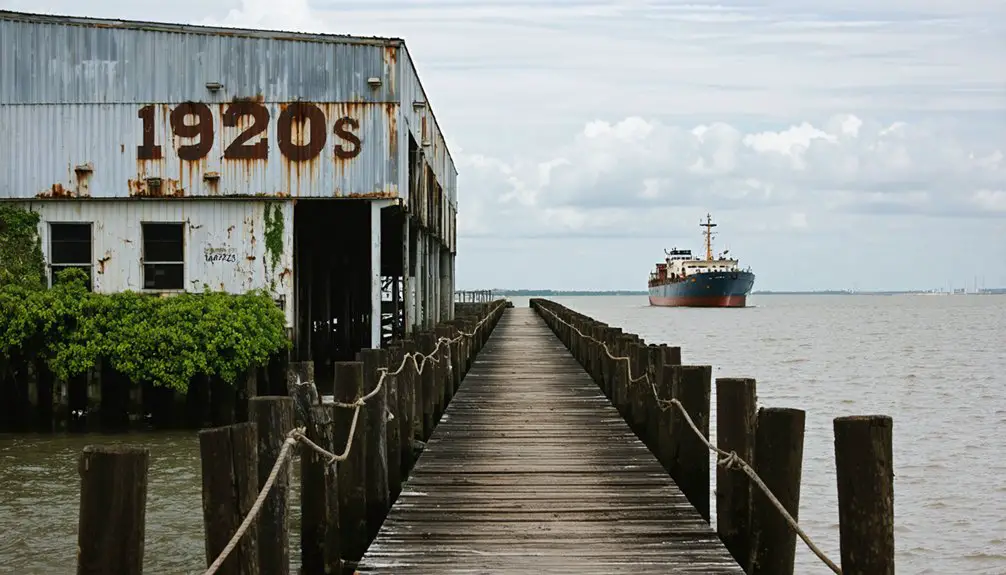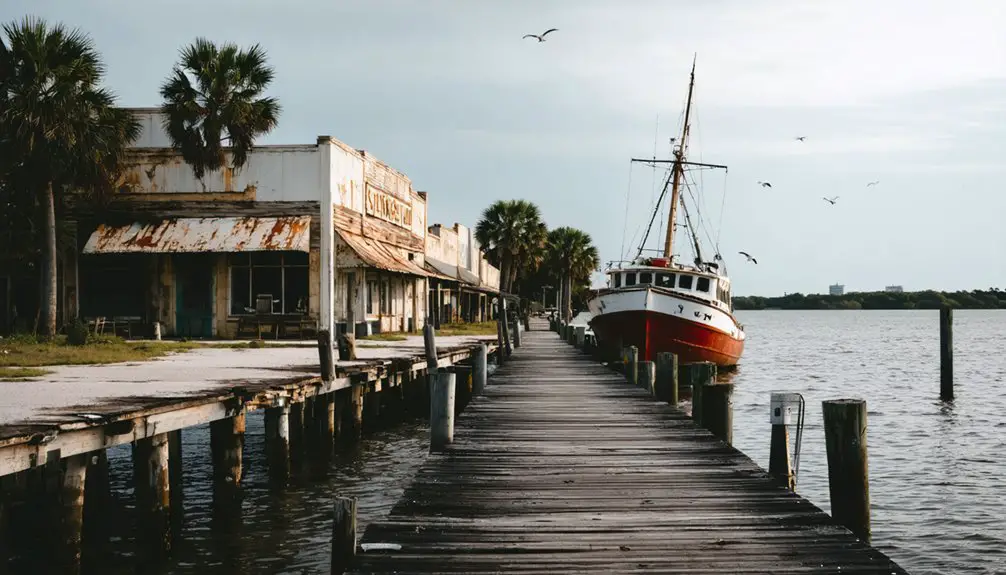You’ll find Port Tampa, now a historic district within Tampa, Florida, as a former railroad boomtown established in 1888 by Henry B. Plant. It served as the terminus of his South Florida Railroad and thrived as a major shipping hub for phosphate and citrus. While the original port operations declined in the 1960s after relocating to East Bay’s Rockport facility, you can still explore the area’s scattered remnants, including original brick roads and maritime structures that tell tales of its prosperous past.
Key Takeaways
- Port Tampa was a thriving maritime community centered around Henry Plant’s railroad terminus and shipping operations in the late 1800s.
- The area experienced significant decline after phosphate operations moved to Rockport and Cuba’s 1960 embargo affected trade routes.
- Original brick roads, deteriorating staircases, and military remnants from Fort Dade still exist in the former port community.
- The development of air freight and interstate highways contributed to Port Tampa’s transformation from bustling port to quiet residential area.
- While technically inhabited today, Port Tampa retains a ghost town atmosphere with scattered historical structures and maritime industrial ruins.
Early Settlement and Indigenous Roots
Long before Port Tampa emerged, indigenous peoples thrived along Tampa Bay’s shores for thousands of years. The Manasota culture first appeared around 500 B.C., eventually evolving into the Safety Harbor culture by 700 A.D. Their indigenous livelihood centered on marine resources, with settlements dotting the coastline. Cuban fishermen established fishing villages alongside these indigenous communities.
The region’s chiefdom dynamics included four major groups: the Tocobaga near Safety Harbor, Uzita along the southern shore, Mocoso on the eastern side, and Pohoy around Hillsborough Bay.
These societies built impressive temple mounds and central plazas, leaving behind shell middens that reveal their maritime-based economy. Their prosperous way of life faced devastating changes when Spanish conquistadors arrived in the early 16th century, bringing disease and warfare that eventually led to the near-complete eradication of these native communities. Hernando de Soto made direct contact with the local tribes during his expedition through the region.
The Rise of Port Tampa’s Maritime Economy
As Tampa Bay’s maritime potential became evident in the late 19th century, Port Tampa emerged as an essential transportation hub through Henry Bradley Plant’s strategic development of integrated steamship and railroad networks.
The port’s maritime connectivity revolutionized regional commerce and transformed Tampa’s economic landscape. A $350,000 Congressional appropriation helped establish the initial dredging operations that would shape Tampa’s commercial future. Today, Port Tampa Bay stands as Florida’s largest port, continuing its legacy of maritime excellence.
Port Tampa’s shipping networks sparked an economic renaissance, reshaping trade patterns and commercial growth throughout Florida’s Gulf Coast region.
- You’ll find the port’s deep channel, dredged in 1889, enabled direct ship-to-rail transfers and accommodated larger vessels.
- You can trace the economic impact through the port’s major exports: phosphate, cigars, citrus, and cattle.
- You’ll notice how steamship routes connected Port Tampa to Key West, Havana, and distant markets by the 1890s.
- You’ll discover the port’s significance peaked during the Spanish-American War when it served as the launching point for Roosevelt’s Rough Riders.
Railroad Development and Industrial Growth
Port Tampa’s railroad terminal underwent major expansion after Henry Plant’s South Florida Railroad reached the port in December 1883, establishing vital links to Jacksonville and points north.
Early phosphate shipping routes emerged through the port by the late 1880s as the railroad tracks were converted from narrow to standard gauge, improving connectivity with other main lines.
The mile-long pier constructed in 1889 allowed direct access to deep water channels, eliminating the need for lighter transfers and streamlining the loading of phosphate onto larger vessels.
Twice daily trains connected Port Tampa with the South Florida Railroad system in the early 1890s, significantly boosting transportation efficiency.
The railroad’s success was largely due to Plant System’s acquisition of South Florida Railroad stock in 1883, which provided crucial financial stability for expansion.
Railroad Terminal Expansion
Railroad magnate Henry B. Plant revolutionized Port Tampa’s landscape in the 1880s through railroad innovation and terminal modernization. His visionary expansion transformed the area into a thriving transportation hub, connecting Tampa to essential maritime routes. Connecting Old Port Tampa to Jacksonville via his ambitious railroad project in 1884 marked a pivotal moment in the region’s development. The Plant Investment Company played a crucial role in acquiring and building the essential rail lines that would shape Florida’s transportation future.
- You’ll find Plant’s strategic development included dredging channels and building extensive docks to accommodate steamships, creating a deep-water terminal by 1889.
- You can trace how his integrated rail-steamboat system opened new markets for Florida’s citrus and phosphate industries.
- You’ll see how securing the U.S. mail contract for West Indies routes established Port Tampa’s dominance.
- You’ll discover the Tampa Port Authority’s later partnerships with railroad companies continued Plant’s legacy, leading to modern facilities like the Gateway Rail Terminal in 2012, Florida’s first on-dock unit train capability.
Early Phosphate Shipping Routes
When phosphate deposits were discovered in Central Florida during the late 1880s, Tampa quickly emerged as the principal marine shipping hub for this valuable mineral resource.
The phosphate origins in the region coincided perfectly with Tampa’s growing infrastructure, as the city had already established natural port facilities and expanding railroad connections to serve the mines.
You’ll find that these early shipping routes weren’t just about phosphate – they carried cattle and citrus too, but phosphate became the dominant cargo.
The city’s strategic location and deep-water channels made it ideal for connecting Florida’s phosphate industry to national and international markets.
These shipping routes proved so successful that by the mid-20th century, Tampa’s phosphate exports had reached unprecedented volumes, serving markets worldwide.
The Port of Tampa’s significance grew tremendously as phosphate shipments accounted for 90 percent of all outbound cargo by 2001.
The Golden Age of Phosphate Shipping
The discovery of phosphate in Central Florida during the late 1880s transformed Tampa into a bustling shipping hub, marking the beginning of its golden age in phosphate exports.
You’ll find that the phosphate boom reached unprecedented heights between 1941-1953, with production exceeding the previous 50 years combined.
- By the 1960s, you’d see massive infrastructure improvements, including channel deepening to 34 feet.
- The late 1970s brought expanded facilities at Rockport, moving operations away from Harbor Island.
- You could watch ships from Canada, Korea, and the Soviet Union dock at Tampa’s modernized port.
- Channel depths reached 43 feet, accommodating larger vessels that’d revolutionize shipping innovation.
The port’s evolution continued as it handled over 10.7 million tons of phosphate annually by 2001, accounting for 90% of outbound cargo.
Military Presence and Strategic Significance

Spanning nearly two centuries, Port Tampa’s military significance emerged in 1823 with the establishment of Fort Brooke by Lt. Col. George Mercer Brooke.
You’ll find this early military post laid the foundation for Tampa Bay’s strategic deployment capabilities, supporting infantry operations against the Seminoles through steamers and sailing vessels.
The Decline of Port Operations
During the late 1960s, Port Tampa’s operational decline accelerated through a series of interconnected changes that reshaped the region’s maritime commerce.
You’ll find that increased cargo competition and urban disruption drove major transformations across the port’s landscape.
- Phosphate operations consolidated from Port Tampa and Seddon Island to Rockport on East Bay, while Atlantic Coast Line Railroad planned to shift loading to Port Manatee due to downtown traffic complaints.
- General cargo facilities along Garrison Channel vanished as air freight and interstate highways provided faster alternatives.
- Cuba’s 1960 embargo eliminated essential tobacco and fruit trade, leaving the port heavily dependent on bulk commodities.
- Channel depth limitations of 43-44 feet restricted larger vessels, while infrastructure upgrade delays weakened the port’s competitive position against regional rivals.
Archaeological Discoveries and Cultural Heritage

While investigating Port Tampa’s history, you’ll discover extensive shell middens and ceremonial mounds dating back to the 5th century BC, when three indigenous cultures – Manasota, Weeden Island, and Safety Harbor – inhabited the area.
These archaeological sites reveal how native communities strategically positioned their settlements near rich estuary resources, using shell mounds to mark territory and protect valuable fishing grounds.
The excavated artifacts and burial remains from these sites provide critical insights into how Tampa Bay’s earliest inhabitants lived, traded, and adapted to environmental changes over thousands of years.
Indigenous Site Excavations
Archaeological excavations across Tampa Bay have revealed rich indigenous cultural heritage dating back to the 5th century BC, with three major cultures – Manasota, Weedon Island, and Safety Harbor – leaving significant imprints on the region.
These excavation techniques involve careful removal of protective layers to access stratified deposits at significant sites.
- Shell mounds, extending up to 20 feet high and 1,200 feet along Boca Ciega Bay, served as both living spaces and ceremonial centers.
- A remarkable 1,100-year-old Manasotan canoe, stretching 40 feet, remains under preservation.
- Indigenous artifacts discovered through screen-sifting methods include human remains and domestic items dating over 1,000 years.
- Native settlements typically featured dual mound structures – one for ceremonies and another for burials – highlighting complex social organization.
Shell Midden Cultural Significance
The cultural landscape of Tampa Bay’s indigenous peoples reveals itself most prominently in the region’s shell middens – massive accumulations of discarded shells that tell rich stories of coastal life.
These shell mounds served multiple purposes, functioning as ceremonial centers, political gathering spots, and elevated platforms for important structures in flood-prone areas.
You’ll find evidence of complex cultural practices in these sites, where Native Americans held large summer feasts, possibly tied to astronomical events like the Summer Solstice.
The mounds also integrated burial grounds, linking everyday life with sacred traditions. Trading networks connected these communities to distant regions, as shown by artifacts found within the middens.
The Safety Harbor culture particularly left its mark through distinctive architectural features and ceremonial objects, demonstrating their connection to broader Mississippian influences.
Ghost Stories and Local Legends
Since its early days, Port Tampa has cultivated a rich tapestry of supernatural lore, with ghost stories centered around iconic locations like the Don CeSar Hotel and nearby historic sites.
You’ll discover haunted hotels and pirate legends that weave through the region’s history, creating an atmosphere of mystery and intrigue.
- At the Don CeSar Hotel, you can sense the eternal romance of Thomas Rowe and his beloved Lucinda, whose spirits are said to still wander the pink-hued halls.
- Oaklawn Cemetery holds the restless spirits of Charles Owen and countless others, their tragic stories echoing through time.
- The nearby Sunshine Skyway Bridge harbors tales of a mysterious blonde apparition appearing to nighttime drivers.
- Tampa Bay’s waters conceal stories of ghostly pirates like Henry Ross and Henry Castor, who’re said to guard their buried treasures.
Modern Remnants and Historical Preservation

Walking through Port Tampa today, you’ll encounter scattered remnants of its military and maritime past, with portions of original brick roads and deteriorating staircases still visible around former Fort Dade.
The lighthouse on Egmont Key stands as a historical landmark preservation priority, still operating while surrounded by ruined military batteries and fortifications. You’ll find these sites protected under state heritage registers, with ongoing structural integrity assessments guiding conservation efforts.
Access to Egmont Key is boat-only, helping preserve its ghost town atmosphere while limiting tourism impact. As you explore, you’ll notice interpretative signage along maintained pathways that guide you safely around the ruins.
Local historical societies and state park services work together to protect these archaeological treasures from erosion, vandalism, and inappropriate development.
Frequently Asked Questions
Where Exactly Was Port Tampa’s Main Residential District Located?
You’ll find Port Tampa’s residential layout in the southwestern tip of Tampa city limits, near 27.867°N and 82.533°W, bordered by Tampa Bay and MacDill AFB, with historic landmarks along S Cortez St.
What Happened to the Families Who Lived in Port Tampa?
You’ll find that families experienced significant displacement as industrial decline forced them to relocate throughout Tampa Bay and Florida, though some maintained their historical significance through oral traditions and heritage preservation.
Were There Any Schools or Churches in Port Tampa?
You’d find Port Tampa Negro School serving African-American children until the 1950s, with Sacred Heart Parish providing Catholic education nearby. Local families also sent kids to Ballast Point district schools.
What Was the Peak Population of Port Tampa?
You’ll find that Port Tampa’s exact peak population isn’t documented separately, but during its historical significance in the early 1900s, estimates suggest several thousand residents before population decline began mid-century.
Did Port Tampa Have Its Own Local Government?
While Port Tampa didn’t have traditional local governance, it relied on Tampa’s public works for municipal services until 1945, when the area came under the newly formed Hillsborough County Port Authority’s jurisdiction.
References
- https://usghostadventures.com/haunted-places/most-haunted-places-in-tampa-fl/
- https://lizzie-borden.com/ghost-tours/tampa/
- https://www.porttb.com/history
- https://en.wikipedia.org/wiki/History_of_Tampa
- https://abandonedfl.com/city/central-florida/tampa/
- https://stars.library.ucf.edu/cgi/viewcontent.cgi?article=3199&context=fhq
- https://www.tampabay.com/archive/1995/04/02/full-cargo-of-history/
- https://www.youtube.com/watch?v=vJJq0AKHTV4
- https://www.83degreesmedia.com/features/current-dredging-of-Tampa-channel-has-deep-ties-to-past-021219.aspx
- https://en.wikipedia.org/wiki/Port_Tampa_Bay



